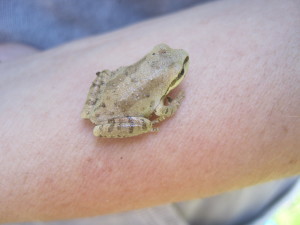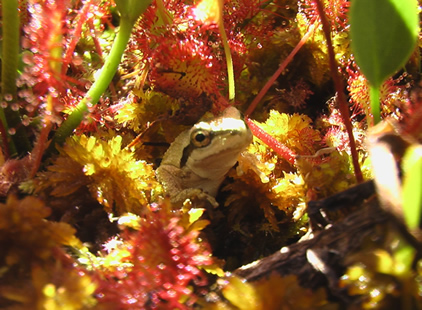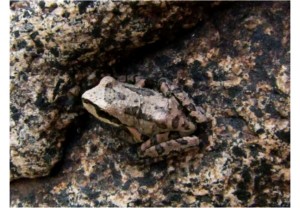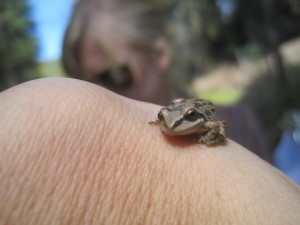The Pacific Chorus Frog, Pseudacris regilla, aka tree frog, has always been a creature of curiosity for me. As each winter ends the song of the chorus frog announces the coming of spring, when the nighttime temperature reaches above 40 degrees. I get excited the first night that their call rings through the air (which sounds like “ooh-yeeh” or “ribbit”) because I know that it usually means a change in the season.
 The chorus frog is tiny after it has metamorphosed from tadpole to frog. No larger than a dime, it leaves it’s watery birthplace and becomes terrestrial. Places where you will often find them is in a meadow or grassy area with water nearby and where there is cover from predators. However they can also be found in woodlands, grasslands, chapparal, and other diverse habitats over a wide range of elevation. Watch your step in wetter meadow areas, I have seen them so thick in grassy meadow vegetation that you must walk very carefully so that you do not step on one.
The chorus frog is tiny after it has metamorphosed from tadpole to frog. No larger than a dime, it leaves it’s watery birthplace and becomes terrestrial. Places where you will often find them is in a meadow or grassy area with water nearby and where there is cover from predators. However they can also be found in woodlands, grasslands, chapparal, and other diverse habitats over a wide range of elevation. Watch your step in wetter meadow areas, I have seen them so thick in grassy meadow vegetation that you must walk very carefully so that you do not step on one.
You can distinguish them from other frog species by the size, which can be smaller than a dime during the metamorph stage and the largest they grow is around two inches. The eye stripe is another distinguishing characteristic.
I have always wondered why they can appear so different in color when they can live so close to one another. I have suspected for some time that they have the ability to camouflage with their home habitat.

Photo by Dan Webster
My suspicion was piqued while on a volunteer workday for CSERC and I noticed a small frog under a granite boulder. This frog was the exact color of the granite and blended in so well that I had a hard time distinguishing the little guy from the rock. Right next to where I sat enjoying my lunch on the boulder there was a clump of grasses and green vegetation where a bright green frog hopped around. How could two frogs live so close together and look so different? I had to know more.
 After talking to CSERC Wildlife Biologist, Megan Fiske, and a little research I found a very informative site to learn more about these adorable little creatures and my suspicion was confirmed. Chorus frogs do have the ability to color adapt to their environment as a defense mechanism against predation. They can change from lighter to darker colors of the same shade, or they can change from grey to brown and to green. The change is actually not triggered by color change in the environment but by the brightness of the background. The color transformation can take weeks and even months, but the first changes in color can be observed within a few hours.
After talking to CSERC Wildlife Biologist, Megan Fiske, and a little research I found a very informative site to learn more about these adorable little creatures and my suspicion was confirmed. Chorus frogs do have the ability to color adapt to their environment as a defense mechanism against predation. They can change from lighter to darker colors of the same shade, or they can change from grey to brown and to green. The change is actually not triggered by color change in the environment but by the brightness of the background. The color transformation can take weeks and even months, but the first changes in color can be observed within a few hours.
To learn much more about these adorable little amphibians check out these sources which we got our information from and while you are out there enjoying nature be on the lookout for our hoppy little friends.
Beartrackers Animal Tracks Den: http://www.bear-tracker.com/treefrog.html
Wikipedia – Pacific tree frog: https://en.wikipedia.org/wiki/Pacific_tree_frog
Photo of Pacific Chorus Frog on Sundew by James Kelly
Photo of Pacific Chorus frog on Granite by Dan Webster
Other photos taken by CSERC staff
-Michelle, CSERC staff

